Coloropus – Review
by Chris
|
 Remember when you were at school (some of you may have to think harder than others) and you were being force-fed information that you knew would be totally fucking useless later on in life? I’m talking about all those maths lessons doing trigonometry, English classes learning about alliteration and, of course, art class. Oh how I scoffed at art class. I couldn’t draw, paint or design anything. There was more artistic talent in Vincent Van Gogh’s missing ear than in my entire body. Not that it mattered, of course. When the hell was I going to use art later on in life? Colours? Painting? What pointless exercise next, teacher?
Remember when you were at school (some of you may have to think harder than others) and you were being force-fed information that you knew would be totally fucking useless later on in life? I’m talking about all those maths lessons doing trigonometry, English classes learning about alliteration and, of course, art class. Oh how I scoffed at art class. I couldn’t draw, paint or design anything. There was more artistic talent in Vincent Van Gogh’s missing ear than in my entire body. Not that it mattered, of course. When the hell was I going to use art later on in life? Colours? Painting? What pointless exercise next, teacher?
Fast forward to my mid twenties and I’m being brought to my knees by a game that looks bouncy and colourful enough to tax only the most attention deficient three year old. Looks can be deceiving however, and Coloropus is one deceptive little son of a bitch.
In Coloropus you take control of a plucky Octopus by the name of Coloropus, whose sole aim is to rescue his love interest, Pinky, as she appears to have got herself trapped in a bottle and dropped deep into the ocean. Stupid girl. Thankfully, Coloropus is smitten and, rather than wandering off and starting a successful-although-questionable art business, he’s decided to use his colour-based powers to free her. That’s essentially the story line, and if it seems straight forward that’s because it is. The beauty of Coloropus isn’t so much in the story as the presentation.
This game is presented to you in such a way that I don’t believe I’ve ever seen with another game: there are no written words… anywhere. Everything is handled through either images or animations in thought bubbles, and it is as simple as it is excellent. Developers have fallen into a habit of including ridiculous overly-in-depth manuals within games and, while I appreciate the need for these to an extent, it’s such a huge amount of information to take in, so you start to wonder if there’s a better way to implement it all. It turns out that the best way is to not do it at all. (So it turns out that EA Games are, in fact, ahead of the game then, rather than ignorant to gamers’ needs – Ed)
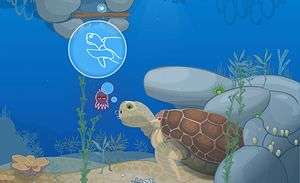 Ok, so that’s not strictly true. While Coloropus doesn’t feature a tutorial or guide by traditional standards, it does give players a nudge in the right direction but this is still done through images via thought bubbles. It really only gives you the basics though, which can mean walking a fine line between the frustration of not knowing what the hell to do with the little innocent blob and cursing the developers for not telling you half of the cool stuff you can do with him. As previously mentioned, developers are so quick to show off all their games’ bells and whistles that I think they forget that half the fun is finding out for yourself.
Ok, so that’s not strictly true. While Coloropus doesn’t feature a tutorial or guide by traditional standards, it does give players a nudge in the right direction but this is still done through images via thought bubbles. It really only gives you the basics though, which can mean walking a fine line between the frustration of not knowing what the hell to do with the little innocent blob and cursing the developers for not telling you half of the cool stuff you can do with him. As previously mentioned, developers are so quick to show off all their games’ bells and whistles that I think they forget that half the fun is finding out for yourself.
Being a puzzler, it would be easy (and commonplace) for Coloropus to lay all its cards on the table and show you what you need to do. It doesn’t, though. It literally tells you how to swim and shoot and doesn’t even remotely hint about all the other crazy crap that goes on. Is this a bad thing? Not in the slightest and, whether intentional or not, developers Pigsels have done two things here: they’ve created a puzzle game, where you need to figure out the actual mechanics themselves as well as the puzzles. In doing that, you become heavily immersed in this very cute-looking, but ultimately deadly, environment.
You strive to understand your character and how he’s going to rescue his love interest, guide him through this adventure and you bond with him, genuinely unsure how you’re going to clear the next hurdle or pass the next obstacle. His thought bubbles and yet his various chirps and noises give him more character than the majority of the mindless drones that Nolan North voices.
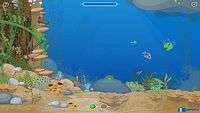 |
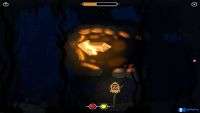 |
 |
 |
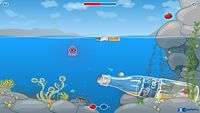 |
 |
As the title suggests, this game is predominately about colours and the use of them to defeat enemies and solve puzzles. Things start off easily enough, as you’re presented with a large area in which to swim around. Swimming is a simple case of pressing the left mouse button, aiming Coloropus with the mouse and pressing the button to get a wiggle on. You have to press each time you want to swim, however, and after a couple of hours having to press every time I wanted to move the little trooper, it started to become a pain, but that’s a minor niggle to be honest. The right mouse button allows you to fire ink. I’m not sure about the factual accuracy behind an octopus shooting ink as I always thought that was just squids. I’m not going to look it up though, so if I turn out to be an under-educated buffoon in animal studies as well as art, we’ll just have to hope that those categories don’t come up next time I’m on University Challenge.
Items can be picked up using the left mouse button, and if you click and hold the button you’ll be able to carry these items around, including rocks, fish bones, corks and anything else you can find lurking in the ocean. Picking up and carrying things turns out to be fairly key for the puzzles, and spinning Coloropus around allows him to fire off the items as a kind of projectile. It doesn’t pick up much speed but it’s there, nonetheless.
 As mentioned before, the main focus in Coloropus is on his ability to manipulate colours. His default colour is white, allowing you to fire white blobs and how long you hold the right mouse button down for determines the size of the blob. You have a finite amount of ink to shoot, which is replenished by eating fruit (naturally), and this is found both under water and on the surface. Accessing things above the water line is a case of shooting out of the water at a rate of knots and angling yourself in the arc you want to travel.
As mentioned before, the main focus in Coloropus is on his ability to manipulate colours. His default colour is white, allowing you to fire white blobs and how long you hold the right mouse button down for determines the size of the blob. You have a finite amount of ink to shoot, which is replenished by eating fruit (naturally), and this is found both under water and on the surface. Accessing things above the water line is a case of shooting out of the water at a rate of knots and angling yourself in the arc you want to travel.
In order to fire other colours, Coloropus has to locate different coloured pellets which can routinely be found in two places: either growing from a plant or located within the body of an enemy fish. At first you have spaces for two colours and the colours you pick up affect how Coloropus can interact with the environment. It’s this exploration and mechanic which partly makes up the fun of the game. You spend time experimenting with different colours, trying to remember where each one was, what colours you need to mix, and where the puzzle was. Even better still is that some colours will require a certain area to enter but will require a different colour to be used on the inside. Working these challenges out is both rewarding and plenty of fun but if, like me, you’ve got a very basic (read: pathetic) understanding of colours and the mixing of them, then you’ll struggle as I did. You know you’re no Pablo Picasso when you’re Googling how to create purple or orange. Moron.
The majority of the game is tackling other fish and puzzles with colours. Most of the fish are bigger than you so require a few hits before going down, and if you don’t have the colour of the fish you’re fighting, it’s going to be a very one-sided affair. You do have to pick your battles well, because without the right colour you’re essentially defenseless. The puzzles are clever and fun without ever being too taxing, and provide a few distractions from the tale of rescuing Pinky. The game never leaves you totally clueless as to how to solve them and instead asks players to explore and discover how they might be solved. These are always through visual cues, either as a thought bubble from our intrepid Coloropus or through the environment itself. There’s nothing to click for a hint; it’s literally always down to looking at what’s in front of you.
You will die in this game; there’s no doubt there. Enemies tend to be fairly powerful and Coloropus struggles to escape even the smallest of jaws. The question is, will you go to this game’s concept of heaven or hell? Coloropus comes with it’s very own morality system and I use the phrase ‘morality system’ very lightly. Your actions within the world affect a morality meter that fades in and out on screen, giving positive karma for planting things in the ground and helping crabs find their lost shells, but negative karma for killing plant life and breaking things. The meter’s alignment when you perish determines where you’ll be transported to. Death may come quickly in Coloropus but, as we all know, when you die it’s just a case of helping your spirit to find your corpse and reuniting the two. Chances are that the powers that be have hidden your corpse behind some fiendish puzzle but what can I say, death’s a bitch.
Throughout the adventure you can also collect orbs, which are hidden in various places and increase different attributes for Coloropus. Due to the lack of actual words it can be tricky to work out what they actually do but I think it’s increase health and speed, and a third attribute but I’m not too sure what that is. Maybe damage? I’m not sure, but I figured that smashing yellow things and absorbing the contents can’t be bad unless I’m in hospital and it’s a bag of piss.
 Graphically, Coloropus is a beautiful game and, for a game that’s largely based on colours, it needs to be; it should stand out and look awesome, which it succeeds in doing. Various combinations of pellets bring out a full palette of colours which light up the area around the little innocent blob. As the game progresses, you move further, from the sunny blue seas into the dark and murky depths of the ocean, fully aware that the only things you’ll find down here will see you as an hors d’oeuvre before eating a shark or a whale. The deeper you go, the more the mood changes.
Graphically, Coloropus is a beautiful game and, for a game that’s largely based on colours, it needs to be; it should stand out and look awesome, which it succeeds in doing. Various combinations of pellets bring out a full palette of colours which light up the area around the little innocent blob. As the game progresses, you move further, from the sunny blue seas into the dark and murky depths of the ocean, fully aware that the only things you’ll find down here will see you as an hors d’oeuvre before eating a shark or a whale. The deeper you go, the more the mood changes.
Suddenly the beautifully crafted, friendly environment is a dangerous place, full of deadly things. It still looks incredible though, and one of Coloropus’ greatest strengths is how it looks. A word of warning, though, it is incredibly colourful. Years of brown and grey corridors have turned down my sensitivity to colour, and I ended up with a headache after an hour of play, so adjust your monitor accordingly if you’re used to playing the same old shooters day in, day out.
 |
 |
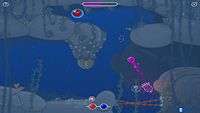 |
 |
 |
 |
Complementing the graphics is the sound; it’s a fantastic score and it’s honestly one of the most relaxing pieces of music I’ve ever heard. As with the graphics, the music changes as you plummet to the depths of the ocean, with danger being reflected with a change of sound, as is victory over a particularly difficult foe. I won’t spoil it, but the music that plays and the image that appears after defeating a boss is worth the price of the game alone.
Pros- A charming little game
- Beautifully presented and designed
- Clever use of colours, not seen anything lie it in any title I've come across before
- Excellent sound
- Fairly short
- May be too challenging for younger gamers
Coloropus is a game I'd recommend to people who want something different as it's a great title and well worth your time. The little guy has got buckets of charm, and I honestly wanted to get him to the end of the adventure. The gameplay is enjoyable, and the use of colours very intuitive. It's a gorgeous game boasting fantastic visuals and an excellent soundtrack. It doesn't take too long to finish the game although younger gamers may find it tricky as, even though it may look ideal for children, it's actually tougher than it appears in places. A fantastic game nonetheless, and those looking for a change of pace, won't find anything better than Coloropus.
Last five articles by Chris


























I loved the idea behind this, I’ll have to be honest. Not so much utilising colours or anything like that, but just how the game operates from an accessibility standpoint… to be playable by people who can’t read, people who speak any language… that’s damned inspired. I love the idea of how the puzzle areas work too though, having to use specific colours and remembering where you picked them up.
Until the review, I was only impressed by the symbolic nature of how the game handles, but now I’m thinking I’ll pick it up some day. Not for a while yet though; got too many other games to get through.
I have to admit, I love the idea of this, but at the same time it’s not something I’d honestly find myself jumping at the chance to play. I wish them success though, and hope it inspires a lot of companies to try similar approaches in future!
I love the sound of this game and think that the fact the devs have managed to create it as a text free experience is incredible. It makes it far more accessible for gamers of all ages and reading abilities and renders the language barrier pretty obselete – inspired. It looks gorgeous and the gameplay sounds simple but intriguing – though, like you, my memory of colour mixing is patchy at best. Really enjoyed the review and I look forward to getting stuck into this one, although ‘stuck’ may well be too right.